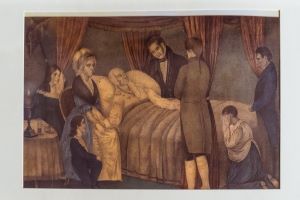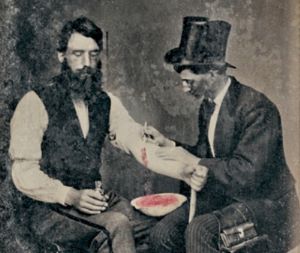2500 mL
A story from US history involving early phlebotomy practices and a gruesome death.
by Shanise Keith • January 31, 2022
One of my absolute favorite stories is about the tragic and shocking death of a famous historical American figure. This man died within 48 hours of his first symptoms, and the physicians who attended to him played a major part in increasing how quickly he died using a phlebotomy practice known as bloodletting. If you have heard this story before, you probably already know that I am talking about George Washington, the very first president of America.
As the story goes, 67-year-old George Washington had recently retired as president. He became ill after he had spent the day outside working on his property in the rain. When he returned home, there were guests over for dinner, and not wanting to be rude, he stayed and entertained them instead of changing out of his wet clothes. The next day he also spent working outside in the cold weather, his throat worsening as time passed. That same night he woke up with his throat so painful and swollen he was having a hard time breathing.

It is not known exactly what caused his sore throat. Some speculate that it was an acute epiglottis infection, but it came on fast, whatever it was. Along with causing swelling in the throat it is also speculated that the infection caused septicemia, which occurs when bacteria enters the bloodstream. It is deadly without proper treatment, even in today's world. His personal physician was called, and the first of four bloodlettings was performed. He drained half a pint (250mL). George Washington actually favored this procedure, and he'd had it done a few times in the past.
Bloodletting was a very common practice at the time and was often performed in situations like this due to the incorrect belief that it would help reduce the amount of swelling/inflammation in the body (less blood = more room in the body = less swelling). Blood was believed to be one of the four humors of the body, which included black bile, yellow bile, phlegm, and blood. Illnesses were treated depending on which humors were affected or symptoms were occurring.
Unfortunately, that first bloodletting of the night was just the beginning of a miserable end. Two more physicians were summoned to help, and various treatments were tried. He was bled three more times, made to throw up, given an enema, and they used a toxin from an insect to create blisters on his neck in an attempt to reduce the swelling, another strange treatment used at the time. During his final bloodletting, they drained at least 32oz (almost a full liter of blood).
Finally, Washington had had enough. He requested for all the treatments to stop and thanked the physicians for their work. He then made arrangements for his death which included that he not be buried for three days after his passing (in case he was not actually dead). He died that morning with his wife by his side. It is estimated that over 2500 mL of blood were drained from him through all the combined bloodlettings. That is around 40% of his blood volume. Losing that much blood did not help in any way, and it certainly sped him towards his end.
To give some examples of how much blood was taken from Washington, 2500 mL of blood is equal to:
- 1 1/2 two-liter soda bottles
- 10 1/2 school lunch milk cartons
- 0.6 of a gallon
- almost two full 44oz soda cups
- 4 1/2 Grande size cups from Starbucks
- 625 4 mL blood tubes
While you may have heard this story of our first president's death, you may not have heard that a fourth physician showed up a few days after George Washington had passed. He was devastated to learn that he had arrived too late, and his friend had already died. This physician proposed trying to revive Washington's body, days after his passing, by transfusing it with lamb's blood. He also wanted to create a hole in his throat to bypass the swollen area making it possible for him to breathe. He believed this would bring Washington back to life. His proposal was denied, which would bother this physician for years. He genuinely believed this attempt would resuscitate the body.

The healthcare practices at the time were often horrific, agonizing, and fuel for nightmares. The typical life expectancy was only 30-40 years, so Washington was well past the average. All of these things sound like something from a horror novel, and in fact, Frankenstein, written by Mary Shelly, was published in 1818 (19 years after his death). I am sure there was plenty of real-life inspiration to help with writing a story about reviving a dead body (the lamb's blood transfusions had been tried before), and it was not uncommon for someone who was believed to be dead to miraculously return to life a couple of days later.
All in all, I am incredibly grateful to live in a world with the medical and scientific advances that we have now. These events only occurred 222 years ago, which is not that much time, but we know there is much more to health than the four humors they based health on then. We have antibiotics to save septic patients, we know how to tell if someone is alive or dead, and we know that blood works best when it remains inside the body.
Sources used:
"The Death Of George Washington". George Washington's Mount Vernon, 2022, https://www.mountvernon.org/library/digitalhistory/digital-e....
"Dr. Thornton's Radical Idea Of Bringing George Washington Back To Life". George Washington's Mount Vernon, 2022, https://www.mountvernon.org/george-washington/death/death-de....
Related Posts and Information
overall rating: my rating: log in to rate
bloodletting death George Washington history YouTube physician Shanise Keith
